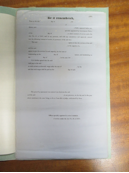The form and the letter
This document is not a letter, but not entirely not one either. Say 90% not, but with a 10% hint of epistolarity hanging about it.
epistolarity hanging about it.
As close perusal shows, it is a form, in English, printed for use in the 1860s, under the terms of two 1857 Acts passed by the Cape Legislative Assembly (PUn9-7643). The Acts? These were the ‘Kaffir Employment Act’ no. 27, and the ‘Kaffir Pass Act’ no. 23 of 1857, with the ‘K word’ now one of great opprobrium in South Africa, at least as insulting as the ‘N word’ in Britain, the US and elsewhere.
The Acts were passed in the wake of the Eighth Frontier War (1851-1853) and around the ‘great cattle killing’ millenarian movement among the Xhosa of 1857, which led to thousands of deaths by starvation and a movement of desperate Xhosa people into the white-controlled labour markets of the Cape, Transvaal, Free State and Natal. The effect of the Acts was that black people generally (not just Xhosa) had to be registered in employment by a named employer and carry a pass if they moved about; and once such a contracted period of employment (usually five years) ended, there was a fourteen day period to find successor employment.
The form is quite a complex one. Also it would have been completed in circumstances in which, due to translation and literacy matters, someone might not appreciate exactly what they were signing up to, but with their signature – more usually their mark – being legally binding.
And the hint of letterness clinging to this printed form? It is a document in which key information was written by one person (about another), and communicated to a (local, usually known) third party separated in time and space from them, an administrator within a legal framework. The associated document, the pass, had the same attributes, but with the third parties here being multiple and not known in advance. But neither document had dialogical aspects, there was no sense of a response in kind; and rather than emergent, the purpose of these documents was to try to fix people and things in place, to stop time and change.
Last updated: 2 August 2015





